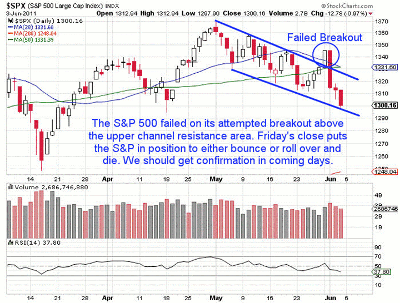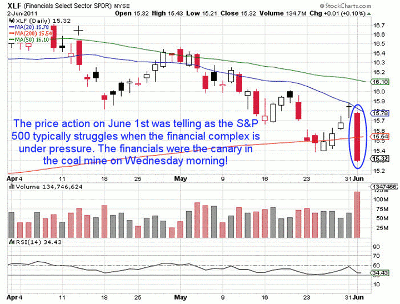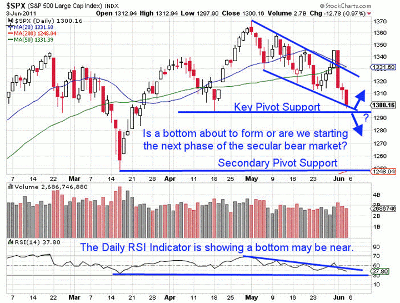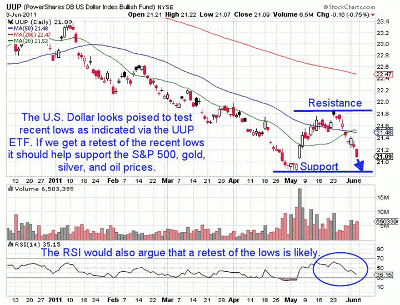To illustrate how crucial it is to closely monitor the key drivers of the marketplace, trader JW Jones explains how watching the financial sector recently kept him out of a certain losing trade.
My most recent analysis regarding the S&P 500 has been proven inaccurate, as a failed breakout transpired on the S&P 500 over the past week. After I watched the S&P 500 break out above the upper channel resistance area, I was expecting continuation. What transpired the following day was absolute carnage in the marketplace.
Immediately after breaking out to the upside, the S&P 500 sold off sharply, and by the end of the day last Wednesday, a failed breakout was obvious. The failed breakout trapped momentum traders as well as those watching and waiting for the breakout to occur.
The chart below illustrates the failed breakout and the subsequent selloff that transpired the rest of the week.
This false break is a good example of why I rarely chase breakouts unless I see multiple days of price stabilization above breakout levels. Generally, a consolidation zone above a key breakout level is bullish. However, in recent months, it seems that some standard technical patterns have not been working well in this choppy, mild downtrend.
I am constantly monitoring price action in the financial sector (Select Sector SPDR – Financial (XLF)) and Wednesday morning was no exception. The ugly price action in XLF kept me from getting involved in a long S&P 500 trade. By late in the day Wednesday, XLF had proven to be accurate and prevented losses for myself.
The chart of XLF at the close on Wednesday looked like this:
The point of the article is not to pat myself on the back for avoiding catastrophe, but to illustrate to readers how important it is to monitor various aspects of the marketplace. I generally focus on the S&P 500 (SPY), the Volatility Index (VIX), XLF, the iShares Russell 2000 ETF (IWM), and the iShares Dow Jones Transports ETF (IYT).
NEXT: Get Critical Market Clues from These Underlying Assets
|pagebreak|Generally speaking, a trader can learn a lot about the broad marketplace by monitoring the price action in the underlying assets mentioned above. Often times, the Russell 2000 or the financial complex will throw off clues about which direction price action is favoring.
At first glance, we could see the S&P 500 bounce higher in coming days, as it is coming into a key pivot low that dates back to April 18. I am expecting some buying support to step in around that price level, as it also corresponds with the lower bound of the recent descending channel the S&P 500 has been trading in.
While we may see further downside, the April 18 pivot low should offer a solid risk-definition area for traders. If prices push lower, a short trade using a stop somewhere around or above the key 1,295 price level would make sense. Those looking to take the S&P 500 long could place a stop order below the key 1,295 price level to define risk.
Regardless of where one believes the S&P 500 is headed, using a key support/resistance level to place trades with limited risk makes a lot of sense currently. I will be patient and wait for the market to throw off clues as to which direction it favors before accepting additional risk.
The primary focus for traders during periods of wild price action should be to concentrate on reducing risk and allowing others to do the heavy lifting.
A trader or an investor can learn a lot about the strength of an underlying asset or index by simply watching the price action while sitting on the sidelines. The daily chart of the S&P 500 Index below illustrates the key pivot level:
Obviously the S&P 500 is coming into a key support zone, but another factor which cannot be ignored at this point in time is the US dollar index. Last Friday, the dollar pushed significantly lower, and most of the key commodities, such as gold, silver, and oil all closed the day near day highs and well off of intraday lows.
The US dollar index looks vulnerable currently, as its recent rally seems to be short-lived and it appears to be poised to retest the recent lows. The daily chart of the PowerShares DB US Dollar Index Bullish ETF (UUP) is shown below:
The remaining trading days of this week should provide us with clues about price action in the S&P 500 and the US dollar. If the dollar continues to weaken, it should help support the S&P 500 and the commodity complex.
For right now, I’m going to sit on the sidelines and wait for the price action to set up before taking on additional risk. The key level to watch is the 1,295 level on the S&P 500 and the recent lows on the US dollar index.
With QE2 winding down and price action starting off the month relatively ugly, June could shape up to be a very interesting month for investors and traders alike. Anything could happen, but this is the closest we have been to rolling over in the S&P 500 for months. I do not have my helmet on yet, but in a couple weeks, depending on price action, I might have to wipe the dust off of it.
By JW Jones of OptionsTradingSignals.com

























